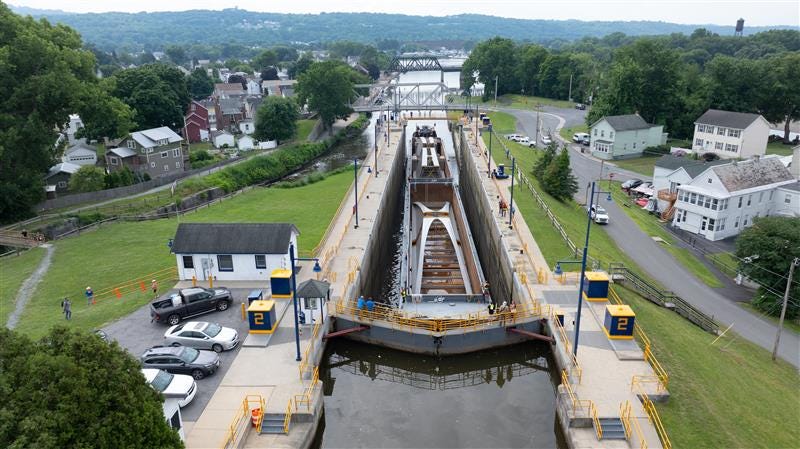Engineers of the Erie Canal
One of New York’s most recognizable attractions, the Erie Canal, commemorates its bicentennial this year. A now 200-year-old engineering marvel, it’s amazing to know it was built without any professionally trained engineers!
To mark the milestone, two dedicated engineers who continue to maintain and innovate this vital waterway talk about their engineering career with the Erie Canal – and how working on centuries-old, aging infrastructure can be uniquely innovative and new.
Engineering Journeys Along the Canals
Engineering as a profession is generational for Ambrose (Director of Waterways Maintenance) and Mitchell, (Professional Engineer I) – both water management engineers with the New York State Canal Corporation (NYSCC).
“My interest began from working alongside my dad and grandfather in carpentry and construction,” Ambrose says. “I wanted to design things while also not sitting in an office all the time.”
Similarly, Mitchell’s passion for engineering was ignited by his grandfather, who worked as an engineer for the NYS Department of Transportation. "He would always talk about his projects and what he did, and it was fascinating to me,” says Mitch, who started his career in another government agency before transferring to Canals. “My grandfather told me, 'That is the best, most interesting place to work. They have some of the oldest structures!'”
Both Ambrose and Mitch say Canals provides variation and excitement, especially since their work touches on elements of environmental and geotechnical engineering.
"We’re working on locks, reservoirs, dams…,” says Ambrose. “It’s just a different level of engineering with the variety of things Canals owns."
Mitch was similarly drawn to the unique challenges and historical significance of the canal system. "We’re working on a 200-year-old structure and get to be innovative while also thinking logically,” he says. “You think about what the idea was back then. Like, ‘why did they build it this way?’ A lot of it was limited technology in the machinery and was all hand labor, essentially.”
Both say the collaboration and teamwork at Canals is a key reason they love their work.
"People are willing to share ideas,” Ambrose says. “I learn as much from our employees out in the field as maybe they learn from me."
Tradition, Innovation and Diversity
There’s an unusual blend of historical practices with modern advancements, like drones and robotics, to working at the Canals.
“You see all the old photos, especially of the original canal. There was no machinery,” says Ambrose. “I think they’d be blown away to see the technology compared to what they had when they built it. How they did that without all the tools we have today is amazing.”
For Mitch, a memorable project was visiting all 57 locks in his first year on the job, as part of the annual inspection team. After base checks of all safety, electrical, mechanical and appearance aspects at each location, the group awards top rankings and prizes.
“What really struck me was the differences between every single lock,” says Mitch. “They're all so unique. Not a single lock is the same as another.”
Vision for the Future
As the Erie Canal system enters its third century of use, with more than 80% of upstate New Yorkers living along the waterway, Mitch hopes it actively remains a part of people’s lives.
“We're historic, yes, while also looking at recreational and commercial potential,” he says. “Whether we're part of their business or general recreation, like fishing, boating or hiking, there’s so much to offer.”
Ambrose agrees. “I really love the investment that the New York Power Authority (NYPA) and the State are making in Canals,” he says about the authority’s assumed ownership of NYSCC since 2017. “With a lot of new infrastructure and maintenance, I’d love to see more use of the Canals. It’s such a great asset for all New Yorkers and beyond – the value is there for the modern day and the next 100, 200 years.”
And the continuity of engineering expertise will be ready for what’s next, too. “We have some great young engineers and it’s been good to recruit,” Ambrose says. “We had a shallow bench for some time, but now there is some remarkable new talent and I’m confident Canals will be in really good hands in the future.”
Fun Facts: Erie Canal Edition
While the Erie Canal wasn’t the first canal in the U.S., it was the most influential and impactful – check out these fun engineering facts:
· The Erie Canal reduced travel time from Buffalo to Albany to just five days (instead of two weeks!).
· It was built without any use of dynamite.
· The main builders of the Canals were land surveyors, not formally trained engineers.
· Dubbed The Erie School of Engineering, almost every American engineer in the first half of the 19th century learned on or from the Erie Canal project. In fact, it prompted several U.S. colleges and universities to start engineering programs.
· In 1967, the Erie Canal was the first non-bridge attraction chosen as a National/International Historic Civil Engineering Landmark by the American Society of Civil Engineers (ASCE).




